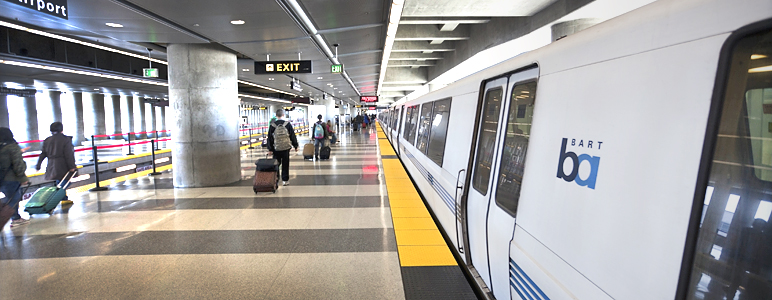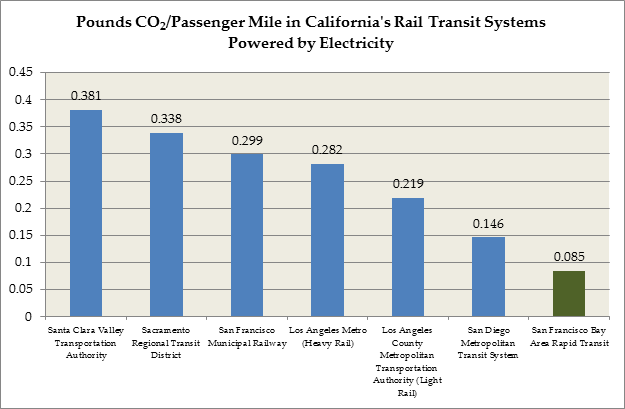


When Governor Brown signed Senate Bill 502 (Leno) into law on August 7, allowing the Bay Area Rapid Transit District (BART) to procure energy directly from eligible renewable energy providers, it not only supported BART's efforts to clean up and modernize its energy portfolio, but also set the stage for expanding transportation sustainability goals statewide.
BART is already a leader in electrified rail transit, with data indicating it operates the cleanest transit rail fleet in California (see chart).1 As SB 502 allows BART to move even faster towards carbon neutrality than the overall grid, it creates a path for BART, indeed all electrified rail systems, to go carbon free and operate essentially as zero‐emission vehicles.
What SB 502 means
Essentially, SB 502 makes BART a direct access customer, allowing it to contract directly for clean energy rather than taking all service through their utility, in this case PG&E. This ability to proactively control energy procurement costs is particularly important to electrified rail transit systems.
SB 502 also signals the intent of the legislature and policymakers to allow and even encourage public transit agencies like BART to go beyond the already ambitious greenhouse gas emission reduction goals set forth for the state's electric utilities. Both of these impacts are in line with the state's efforts to combat climate change and move us toward a sustainable economy powered by clean energy.
Renewable energy option
SB 502 will allow BART to purchase wholesale electricity from a diverse range of eligible renewable resources.2 In today's competitive marketplace for energy, BART can seek clean energy contracts that are resilient, cost-effective and well aligned with BART needs instead of relying solely on the utility or a limited set of approved suppliers. BART can seek out and develop these resources and leverage its size and market power to secure both long- and short-term supplies of energy as a hedge against volatile fossil fuel costs and as part of the agency's overall plans to build a strong clean energy portfolio.
Getting to 2030
Governor Brown has set very ambitious goals for the state, and the legislature continues to show leadership with regard to climate change and is even now considering a 50% Renewable Portfolio Standard for 2030. But we know even that monumental target will not be enough for California to do its part in stabilizing and reducing global concentrations of CO2.
In this regard, SB 502 is also an implicit recognition that we have to go beyond the 50% target and that transit will play a major role. If SB 502 can help BART go “cleaner” further and faster, perhaps the model can be applied to other electrified rail systems, including the California High-Speed Rail Authority, as each develop their own strategic energy and sustainability practices that maximize CO2 reductions. Even with our rapidly clean energy portfolio in this state, we will need this extra “pull” from our electrified transit agencies to achieve our long-term goals.
Alignment with state goals
By empowering BART to build a resilient, modern transportation system and by pushing even higher levels of clean renewable energy into the system, SB 502 continues California's record of environmental stewardship coupled with economic development. We commend Senator Mark Leno and the legislature, governor and BART for their leadership on this matter. The bill will be law January 1, 2016.
1 Source: U.S. Department of Transportation Federal Transit Administration, “Public Transportation's Role in Responding to Climate Change.” Data calculated from Federal Transit Administration 2008 National Transit Database (NTD), U.S. Department of Energy carbon dioxide conversion factors, U.S. Environmental Protection Agency eGRID.
2 RPS eligible resources include biodiesel; biogas/biomethane; biomass; conduit hydroelectric; digester gas; fuel cells using renewable fuels; geothermal; hydroelectric incremental generation from efficiency improvements; landfill gas; municipal solid waste; ocean wave, thermal and tidal current; photovoltaic; small hydroelectric; solar thermal electric; and wind.


